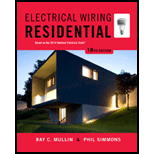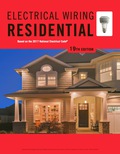
Electrical Wiring Residential
18th Edition
ISBN: 9781285170954
Author: Ray C. Mullin, Phil Simmons
Publisher: Cengage Learning
expand_more
expand_more
format_list_bulleted
Concept explainers
Question
Chapter 28, Problem 4R
To determine
Check whether a
Expert Solution & Answer
Want to see the full answer?
Check out a sample textbook solution
Students have asked these similar questions
Don't use ai to answer I will report you answer
NO AI PLEASE will reject.
NO AI PLEASE will reject.
Chapter 28 Solutions
Electrical Wiring Residential
Ch. 28 - What is the minimum size service for a one-family...Ch. 28 - Prob. 2RCh. 28 - Prob. 3RCh. 28 - Prob. 4RCh. 28 - Prob. 5RCh. 28 - Prob. 6RCh. 28 - Prob. 7RCh. 28 - List the standard sizes of fuses and circuit...Ch. 28 - Prob. 9RCh. 28 - Using the method shown in this unit, what is the...
Ch. 28 - State four possible combinations of service...Ch. 28 - Which Code section states that all overcurrent...Ch. 28 - All electrical components have some sort of...Ch. 28 - Arc-fault damage is closely related to the value...Ch. 28 - The utility company has provided a letter to the...Ch. 28 - While working on the main panelboard that is...Ch. 28 - Repeat problem 16 for a main service panel that...Ch. 28 - NEC ______________________________ generally...Ch. 28 - Prob. 19RCh. 28 - Prob. 20RCh. 28 - Overcurrent devices must be accessible. (True)...
Knowledge Booster
Learn more about
Need a deep-dive on the concept behind this application? Look no further. Learn more about this topic, electrical-engineering and related others by exploring similar questions and additional content below.Similar questions
- How can I design a socket for a trolley headlight? What parameters should I measure? The only thing I have is the headlight itself, and I don’t have any information about its power, current, or voltage rating. The power source is 120 V, and my goal is simply to get the headlight to turn on.I’m not sure where to start or what to measure. Any recommendations would be greatly appreciated!arrow_forwardFigure 2 3) *** The circuit of Figure 3 is designed with W/L = 20/0.18, λ= 0, and ID = 0.25 mA. (Optional- 20 points) a) Compute the required gate bias voltage. b) With such a gate voltage, how much can W/L be increased while M1 remains in saturation? What is the maximum voltage gain that can be achieved as W/L increases? VDD = 1.8 V RD 2k - Vout Vin M₁ Figure 3arrow_forward1) Rs = 4kQ, R₁ = 850 kQ, R₂ = 350 kQ, and R₁ = 4 kQ. The transistor parameters are VTP = -12 V, K'p = 40 µA / V², W/L = 80, and λ = 0.05 V-1. (50 Points) a) Determine IDQ and VSDQ. b) Find the small signal voltage gain. (Av) c) Determine the small signal circuit transconductance gain. (Ag = io/vi) d) Find the small signal output resistance. VDD = 10 V 2'; www www Figure 1 Ссarrow_forward
arrow_back_ios
SEE MORE QUESTIONS
arrow_forward_ios
Recommended textbooks for you
 EBK ELECTRICAL WIRING RESIDENTIALElectrical EngineeringISBN:9781337516549Author:SimmonsPublisher:CENGAGE LEARNING - CONSIGNMENT
EBK ELECTRICAL WIRING RESIDENTIALElectrical EngineeringISBN:9781337516549Author:SimmonsPublisher:CENGAGE LEARNING - CONSIGNMENT

EBK ELECTRICAL WIRING RESIDENTIAL
Electrical Engineering
ISBN:9781337516549
Author:Simmons
Publisher:CENGAGE LEARNING - CONSIGNMENT
Series compensation of long transmission lines; Author: Georg Schett;https://www.youtube.com/watch?v=smOqSxFBvVU;License: Standard Youtube License